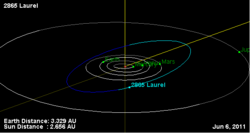Astronomy:2865 Laurel
 2865 Laurel orbit, and his position on 06 Jun 2011 (NASA Orbit Viewer applet) | |
| Discovery [1] | |
|---|---|
| Discovered by | C. Jackson |
| Discovery site | Johannesburg Obs. |
| Discovery date | 31 July 1935 |
| Designations | |
| (2865) Laurel | |
| Named after | Stan Laurel (film comedian)[2] |
| 1935 OK · 1939 PA 1947 NF · 1951 ML 1972 QH | |
| Minor planet category | main-belt · (middle) [3] Maria |
| Orbital characteristics [1] | |
| Epoch 4 September 2017 (JD 2458000.5) | |
| Uncertainty parameter 0 | |
| Observation arc | 81.62 yr (29,810 days) |
| |{{{apsis}}}|helion}} | 2.7406 AU |
| |{{{apsis}}}|helion}} | 2.3812 AU |
| 2.5609 AU | |
| Eccentricity | 0.0702 |
| Orbital period | 4.10 yr (1,497 days) |
| Mean anomaly | 71.330° |
| Mean motion | 0° 14m 25.8s / day |
| Inclination | 14.294° |
| Longitude of ascending node | 321.79° |
| 293.35° | |
| Physical characteristics | |
| Dimensions | 14.73±1.2 km (IRAS:3)[4] 14.79 km (derived)[3] 18.83±0.73 km[5] 24.99±0.37 km[6] |
| Rotation period | 21.5±0.3 h[7] |
| Geometric albedo | 0.094±0.014[6] 0.142±0.013[5] 0.2242±0.043 (IRAS:3)[4] 0.2438 (derived)[3] |
| S [3][8] | |
| Absolute magnitude (H) | 11.20[6] · 11.24±0.30[8] · 11.3[1][3] · 11.40[4][5] |
2865 Laurel, provisional designation 1935 OK, is a stony Marian asteroid from the middle region of the asteroid belt, approximately 15 kilometers in diameter. It was discovered by English-born South African astronomer Cyril Jackson at Johannesburg Observatory on 31 July 1935.[9] The asteroid was named after movie comedian Stan Laurel.[2]
Orbit and classification
Laurel orbits the Sun in the central main-belt at a distance of 2.4–2.7 AU once every 4 years and 1 month (1,497 days). Its orbit has an eccentricity of 0.07 and an inclination of 14° with respect to the ecliptic.[1] No precoveries were taken and the asteroid's observation arc begins with its discovery observation in 1935.[9]
Physical characteristics
Laurel has been characterized as a common S-type asteroid by PanSTARRS' photometric survey.[8]
Rotation period
A rotational lightcurve for this asteroid was obtained from photometric observations by French amateur astronomer Pierre Antonini in September 2005. It gave a longer than average rotation period of 21.5±0.3 hours with a brightness variation of 0.15 in magnitude ({{{1}}}).[7]
Diameter and albedo
According to the space-based surveys carried out by the Infrared Astronomical Satellite IRAS, the Japanese Akari satellite, and NASA's Wide-field Infrared Survey Explorer with its subsequent NEOWISE mission, the asteroid measures between 14.7 and 25.0 kilometers in diameter and its surface has an albedo between 0.09 and 0.22.[4][5][6] The Collaborative Asteroid Lightcurve Link agrees with IRAS and derives an albedo of 0.24 and a diameter 14.8 kilometers.[3]
Naming
This minor planet was named after English-born slapstick film comedian Stan Laurel (1890–1965). Together with Oliver Hardy (1892–1957), who was honored with the main-belt asteroid 2866 Hardy, they formed the first great comedy duo in Classical Hollywood cinema.[2] The official naming citation was published by the Minor Planet Center on 1 September 1993 (M.P.C. 22496),[10] based on a suggestion by Gareth V. Williams and others.[2]
References
- ↑ 1.0 1.1 1.2 1.3 "JPL Small-Body Database Browser: 2865 Laurel (1935 OK)". Jet Propulsion Laboratory. https://ssd.jpl.nasa.gov/sbdb.cgi?sstr=2002865. Retrieved 14 June 2017.
- ↑ 2.0 2.1 2.2 2.3 Schmadel, Lutz D. (2007). "(2865) Laurel". Dictionary of Minor Planet Names – (2865) Laurel. Springer Berlin Heidelberg. p. 235. doi:10.1007/978-3-540-29925-7_2866. ISBN 978-3-540-00238-3.
- ↑ 3.0 3.1 3.2 3.3 3.4 3.5 "LCDB Data for (2865) Laurel". Asteroid Lightcurve Database (LCDB). http://www.minorplanet.info/PHP/generateOneAsteroidInfo.php?AstInfo=2865%7CLaurel. Retrieved 9 July 2016.
- ↑ 4.0 4.1 4.2 4.3 Tedesco, E. F.; Noah, P. V.; Noah, M.; Price, S. D. (October 2004). "IRAS Minor Planet Survey V6.0". NASA Planetary Data System 12: IRAS-A-FPA-3-RDR-IMPS-V6.0. Bibcode: 2004PDSS...12.....T. https://sbnarchive.psi.edu/pds3/iras/IRAS_A_FPA_3_RDR_IMPS_V6_0/data/diamalb.tab. Retrieved 22 October 2019.
- ↑ 5.0 5.1 5.2 5.3 Usui, Fumihiko; Kuroda, Daisuke; Müller, Thomas G.; Hasegawa, Sunao; Ishiguro, Masateru; Ootsubo, Takafumi et al. (October 2011). "Asteroid Catalog Using Akari: AKARI/IRC Mid-Infrared Asteroid Survey". Publications of the Astronomical Society of Japan 63 (5): 1117–1138. doi:10.1093/pasj/63.5.1117. Bibcode: 2011PASJ...63.1117U. (online, AcuA catalog p. 153)
- ↑ 6.0 6.1 6.2 6.3 Masiero, Joseph R.; Mainzer, A. K.; Grav, T.; Bauer, J. M.; Cutri, R. M.; Nugent, C. et al. (November 2012). "Preliminary Analysis of WISE/NEOWISE 3-Band Cryogenic and Post-cryogenic Observations of Main Belt Asteroids". The Astrophysical Journal Letters 759 (1): 5. doi:10.1088/2041-8205/759/1/L8. Bibcode: 2012ApJ...759L...8M. http://adsabs.harvard.edu/cgi-bin/bib_query?bibcode=2012ApJ...759L...8M. Retrieved 9 July 2016.
- ↑ 7.0 7.1 Behrend, Raoul. "Asteroids and comets rotation curves – (2865) Laurel". Geneva Observatory. http://obswww.unige.ch/~behrend/page4cou.html#002865. Retrieved 9 July 2016.
- ↑ 8.0 8.1 8.2 Veres, Peter; Jedicke, Robert; Fitzsimmons, Alan; Denneau, Larry; Granvik, Mikael; Bolin, Bryce et al. (November 2015). "Absolute magnitudes and slope parameters for 250,000 asteroids observed by Pan-STARRS PS1 - Preliminary results". Icarus 261: 34–47. doi:10.1016/j.icarus.2015.08.007. Bibcode: 2015Icar..261...34V. http://adsabs.harvard.edu/cgi-bin/bib_query?bibcode=2015Icar..261...34V. Retrieved 9 July 2016.
- ↑ 9.0 9.1 "2865 Laurel (1935 OK)". Minor Planet Center. https://www.minorplanetcenter.net/db_search/show_object?object_id=2865. Retrieved 9 July 2016.
- ↑ "MPC/MPO/MPS Archive". Minor Planet Center. https://www.minorplanetcenter.net/iau/ECS/MPCArchive/MPCArchive_TBL.html. Retrieved 9 July 2016.
External links
- Asteroid Lightcurve Database (LCDB), query form (info )
- Dictionary of Minor Planet Names, Google books
- Asteroids and comets rotation curves, CdR – Observatoire de Genève, Raoul Behrend
- Discovery Circumstances: Numbered Minor Planets (1)-(5000) – Minor Planet Center
- 2865 Laurel at AstDyS-2, Asteroids—Dynamic Site
- 2865 Laurel at the JPL Small-Body Database
 |

